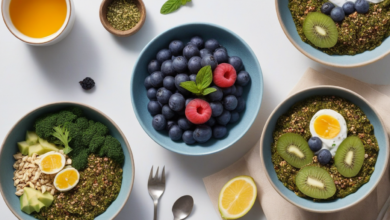Fermented Foods: Why They’re Trending and How to Make Your Own at Home

In recent years, fermented foods have surged in popularity, captivating both health enthusiasts and culinary adventurers alike. This ancient preservation method, which involves the natural process of fermentation, is celebrated for its unique flavors and impressive health benefits. From kimchi and sauerkraut to kombucha and kefir, these foods are not only delicious but also offer numerous advantages for your gut health and overall well-being. In this blog, we’ll explore why fermented foods are trending, and provide you with practical tips on how to make your own at home. Discover the transformative power of fermentation and elevate your culinary repertoire today!
1. Why Are Fermented Foods Trending?
Fermented foods are making a major comeback for several compelling reasons. First, they are packed with probiotics—beneficial bacteria that support gut health. A healthy gut microbiome is crucial for digestion, immunity, and even mental health. Additionally, fermentation enhances the nutritional profile of foods, making them richer in vitamins and minerals. The rising awareness of these health benefits, combined with a growing interest in traditional and sustainable food practices, has fueled the trend.
FAQs:
- What are probiotics, and why are they important? Probiotics are live bacteria that help maintain a healthy balance of gut flora, which is essential for effective digestion and a robust immune system.
- How do fermented foods impact mental health? Research suggests that a healthy gut microbiome can influence mood and cognitive function, potentially reducing symptoms of anxiety and depression.
2. The Health Benefits of Fermented Foods
Fermented foods offer a range of health benefits beyond just probiotics. They can improve digestion, enhance nutrient absorption, and boost immune function. For instance, sauerkraut is rich in vitamin C and antioxidants, while kefir provides a good source of calcium and protein. Moreover, the fermentation process can break down certain compounds that are hard to digest, making nutrients more accessible to the body.
FAQs:
- What other health benefits are associated with fermented foods? Fermented foods can help with weight management, reduce inflammation, and support cardiovascular health.
- Are there any risks to consuming fermented foods? Generally, fermented foods are safe for most people. However, those with certain conditions, like histamine intolerance, should consume them in moderation.
3. How to Make Your Own Fermented Foods at Home
Making fermented foods at home is simpler than you might think and allows you to enjoy fresh, probiotic-rich foods tailored to your taste. Here are some basic recipes to get you started:
Kimchi:
- Ingredients: Napa cabbage, radishes, green onions, garlic, ginger, Korean chili flakes (gochugaru), fish sauce (optional).
- Instructions: Chop the cabbage and radishes, mix with salt, and let sit for a few hours. Rinse and mix with the other ingredients. Pack tightly into a jar and let ferment at room temperature for 1-2 weeks.
Kefir:
- Ingredients: Kefir grains, milk (cow, goat, or plant-based).
- Instructions: Place kefir grains in a jar, pour milk over them, cover with a cloth, and let sit at room temperature for 24-48 hours. Strain the grains and transfer the kefir to the refrigerator.
Sauerkraut:
- Ingredients: Green cabbage, salt, caraway seeds (optional).
- Instructions: Shred the cabbage, mix with salt, and massage until it releases liquid. Pack tightly into a jar, cover with the liquid, and let ferment at room temperature for 1-4 weeks.
FAQs:
- How long does it take for fermented foods to be ready? Fermentation times vary depending on the food and environmental conditions, but typically range from a few days to several weeks.
- How can I ensure the fermentation process is successful? Use clean utensils and containers, follow recipes closely, and taste periodically to monitor progress.
4. Tips for Successful Fermentation
- Use High-Quality Ingredients: Fresh, organic vegetables and high-quality milk yield better results and enhance flavor.
- Maintain Cleanliness: Sterilize jars and utensils to prevent unwanted bacteria from contaminating your fermentation.
- Monitor Temperature: Fermentation thrives at room temperature, but extreme heat or cold can hinder the process. Aim for a stable environment.
FAQs:
- What should I do if my fermentation develops mold? Remove the moldy layer, check for any off smells, and if everything seems fine underneath, continue fermenting.
- How can I flavor my fermented foods? Experiment with herbs, spices, and other flavorings to create custom tastes.
Conclusion
Fermented foods are more than just a trend—they’re a nutritious and delicious way to support your health and enhance your culinary skills. By understanding the benefits and learning how to make your own fermented foods at home, you can enjoy the numerous advantages of probiotics and improved digestion while indulging in flavorful dishes. Embrace the art of fermentation, and elevate your meals with these wholesome, time-honored recipes. Start your fermentation journey today and experience the transformative power of these remarkable foods!




